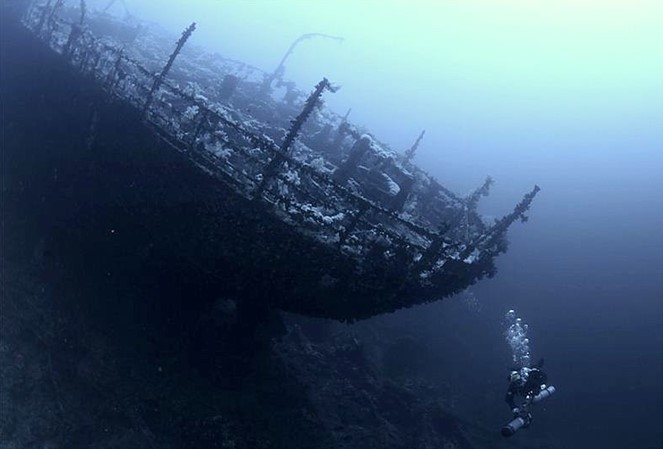4. THE AIDA
The Aida ship is an Egyptian supply ship, originally launched in France in 1911. It weighs 1428 tons and its length is 75 meters long. It is originally ordered for the Egyptian Ports and Lighthouses Administration, she was later transferred to Egyptian Marina and used to ferry troops. It’s located on Big Brother Island approximately 59km ENE of El Quseir. 220m north of the lighthouse and jetty. It Sank on 15 September 1957 while bringing lighthouse staff to the island's jetty. The main reason was an adverse weather caused the ship to strike the rocks as she attempted to unload. The Captain and 76 other personnel were all rescued by a tugboat.
The vessel makes an appearance in the official
British War Diary dated 8 October 1941. The document reads: “SITUATION REPORT
Egypt and Canal Area S. S. ROSALIE MOLLER was sunk by enemy air attack on
Anchorage H.between 0045B and 0140B. S. S. AIDA (Ports and Lights vessel) was
sunk at Zafarana Anchorage by H. E. III which crashed at the same time after
hitting AIDAs mast. S. S. AIDA can be salved”
The bombs from the German aircraft actually scored a near miss and
thinking very quickly, her Captain beached his ship before she could sink. At
this time, throughout the world, Allied shipping was being lost at an
unsustainable rate and every effort was made to salvage any vessel that was not
a total loss. Consequently, the Ada was refloated and repaired and continued in
service until 1957 when she was eventually lost.
Intriguingly, however, having been officially described as
"sunk" during the War, many accounts of the vessel now residing off
the Brothers Islands describe her as the "Ada II" - which is
incorrect.
On 15 September 1957, the Captain of the Ada was tasked to exchange
military personnel on Big Brothers Island. There were heavy storms that day and
it would seem that, despite the sea state, he still decided to go ahead - and
in so doing he struck the rocks. Almost immediately, the Ada began to sink and
the Captain had little option but to abandon ship.
A Tugboat responded immediately and took off 77 personnel with the
remainder, including the Captain, all getting safely to shore. In the meantime,
the Ada drifted a short distance to the northwest before her bows finally
embedded themselves into the reef. As the stern sank, it came to rest at an
extremely steep angle down the reef.
The Depth of wreck is 28 to 52 meters and its Angle of Incline is
Around 40 to 45 degrees (very steep). it seems to defy the forces of gravity. The Wreck condition is good . Its' steel framework is
largely intact except damage to the bow section. Wooden sections have rotted
away.
The Common marine species around the wreck is
Large anemones, groupers, glassy sweepers and clownfish. Soft coral
in orange, purple, red and other vibrant colors. Grey reef and hammerhead
sharks often nearby.
The diving Skill level required for diving to
the wreck is definitely for advanced level diver, due to the depth, incline and
currents. This is an outstanding dive by any standards - with the Diver
left wondering how any ship could come to rest at such an angle. One would have
expected the forces of gravity to have taken over at some point and send the
vessel to a much deeper resting place. But not in this case and the Ada lies
straight "up" the reef with her bows at 25m and her stern at 60m.
Apart from substantial damage to the Bows, this ship is virtually intact.
After more than 40 years underwater, the Ada is now permanently concreted to the Reef on which she has slowly become a part. There is considerable coral growth all over the ship. With decreasing intensity as one ventures deeper and deeper, the Diver will encounter a wide variety of soft corals and hard corals with the shallower parts of the wreck being a veritable living confusion of color. Add to this an amazing selection of fish life which includes everything from large Grouper and Tuna - always found feeding at first light, and the thousands of Vanikoro Sweepers that inhabit No 1 Hold and this is a wreck that has something for everyone.
After the damaged bows, most of the main forward deck is intact. The wooden decking has rotted away - leaving a virtually intact steel framework with easy access to all parts. The forward hold is empty and, once inside, the Diver is totally sheltered from the current - which can be quite strong.












 All
All
 Politics
Politics
 Economy
Economy
 Tourism
Tourism
 Nature
Nature
 Community
Community

